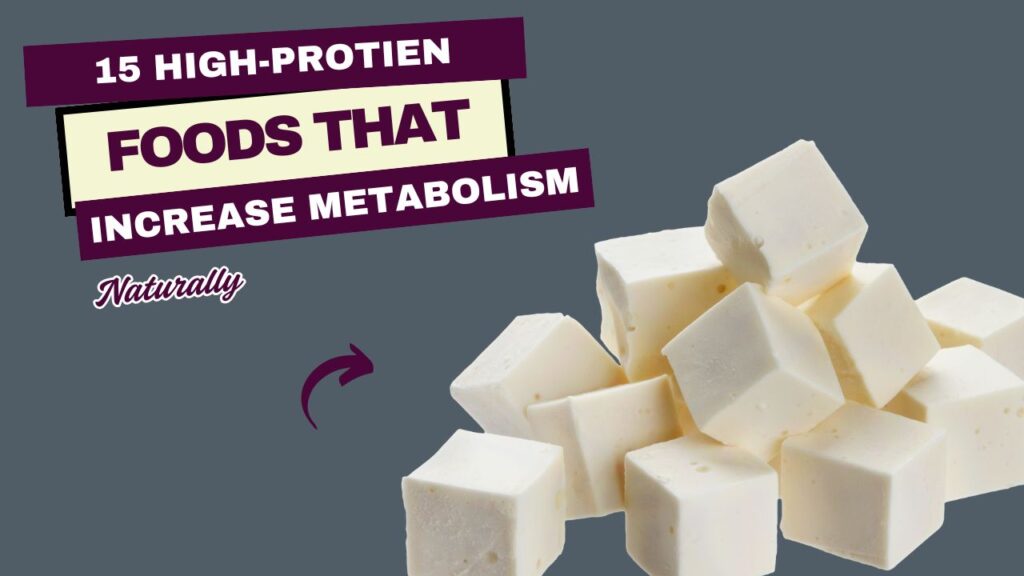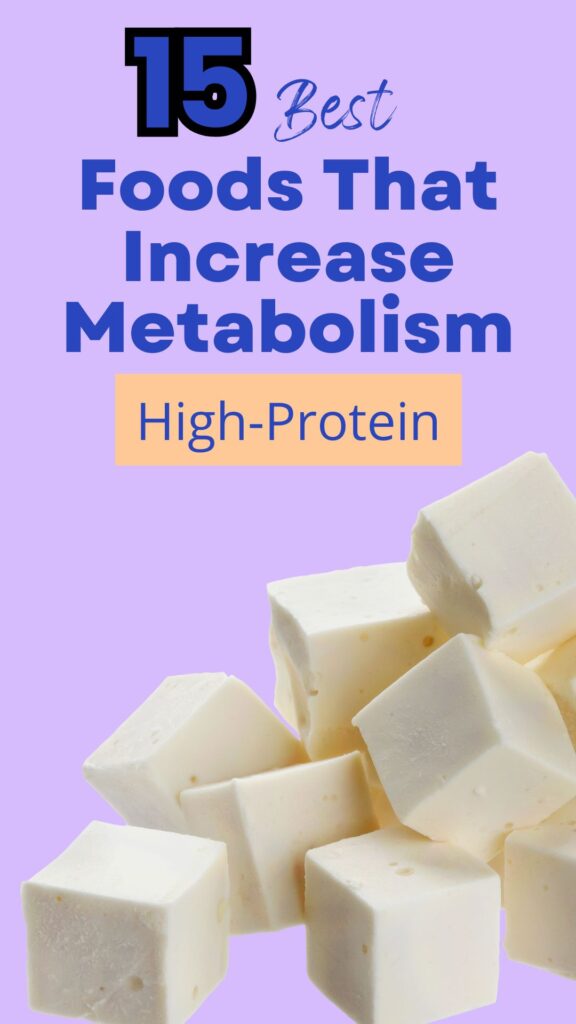Struggling with low energy, stubborn weight, or slow metabolism? What if the solution could start with what’s on your plate? Protein isn’t just for bodybuilders—it’s a powerhouse nutrient that can rev up your metabolism, help with weight management, and support overall health.
Do you know that your body burns more calories digesting protein than it does digesting carbs or fats? This is called the thermic effect of food, and it means that eating protein-rich foods can actually help you burn more calories even at rest.
In this post, we’ll explore 15 high-protein foods that naturally boost your metabolism, share the best ways to enjoy them, who should (or shouldn’t) eat them, storage tips, and potential side effects.
By the end, you’ll have a solid list of protein-packed options to fuel your body and supercharge your metabolism.

Table of Contents

15 Best High-Protien Foods To Eat
1. Eggs
Why they boost metabolism: Eggs are loaded with high-quality protein and essential amino acids, which are crucial for muscle repair and metabolic function.
Best ways to eat:
- Boiled, scrambled, or poached
- Added to salads or grain bowls
- As a protein-rich snack or breakfast omelet
Tips to maximize absorption: Pair eggs with vegetables for extra vitamins and fiber.
Who should eat / avoid:
- Good for: anyone seeking weight loss, athletes, pregnant women
- Avoid if: egg allergy
Storage & buying tips:
- Buy fresh eggs and store in the fridge in their carton
- Keep away from strong-smelling foods to prevent odor absorption
Do’s & Don’ts Table:
| ✅ Do | ❌ Don’t |
|---|---|
| Eat boiled or poached eggs for maximum nutrients | Overcook scrambled eggs to dryness |
| Include eggs in balanced meals | Store eggs at room temperature for long periods |
Possible side effects: Overconsumption may raise cholesterol in some individuals; moderation is key.
2. Greek Yogurt
Why it boosts metabolism: High in protein and probiotics, Greek yogurt supports gut health and muscle repair, which can indirectly improve metabolic rate.
Best ways to eat:
- Smoothies or parfaits
- Topped with nuts and fruits
- As a creamy salad dressing
Tips: Pair with fruits rich in vitamin C to enhance protein absorption.
Who should eat / avoid:
- Good for: adults, athletes, those seeking weight management
- Avoid if: lactose intolerant (unless using lactose-free yogurt)
Storage & buying tips:
- Choose plain, unsweetened Greek yogurt for maximum benefits
- Store in fridge, consume within 5–7 days
Do’s & Don’ts Table:
| ✅ Do | ❌ Don’t |
|---|---|
| Mix with berries for antioxidants | Choose flavored yogurts high in sugar |
| Use as a snack or meal topping | Leave opened yogurt out of fridge |
Possible side effects: Some may experience bloating if lactose intolerant.
3. Chicken Breast
Why it boosts metabolism: Lean chicken breast is packed with protein and low in fat, perfect for muscle building and calorie burning.
Best ways to eat:
- Grilled or baked for main meals
- In salads or sandwiches
- Stir-fried with vegetables
Tips: Avoid deep-frying; grilling helps retain protein without adding excess fat.
Who should eat / avoid:
- Good for: weight loss seekers, athletes, general health
- Avoid if: allergies to poultry
Storage & buying tips:
- Buy fresh or frozen chicken; keep refrigerated at ≤40°F (4°C)
- Use within 1–2 days if fresh, longer if frozen
Do’s & Don’ts Table:
| ✅ Do | ❌ Don’t |
|---|---|
| Grill or bake | Deep-fry or overcook |
| Store properly in fridge | Leave raw chicken at room temperature |
Possible side effects: Undercooked chicken may cause foodborne illness.
4. Salmon
Why it boosts metabolism: Salmon is rich in protein and omega-3 fatty acids, which help improve muscle function and fat metabolism.
Best ways to eat:
- Baked or grilled
- In salads or poke bowls
- Smoked as a protein-rich snack
Tips: Pair with vitamin D sources like leafy greens for better absorption of fat-soluble nutrients.
Who should eat / avoid:
- Good for: heart health, muscle growth, and metabolism
- Avoid if: seafood allergy
Storage & buying tips:
- Fresh salmon should be consumed within 1–2 days
- Frozen salmon can last several months in the freezer
Do’s & Don’ts Table:
| ✅ Do | ❌ Don’t |
|---|---|
| Bake or grill for healthy fats | Overcook and dry out |
| Use fresh or frozen salmon | Store in warm environments |
Possible side effects: Mercury content is low but avoid excessive consumption of large fish varieties.
5. Cottage Cheese
Why it boosts metabolism: Low-fat cottage cheese is protein-dense, helping preserve lean muscle while supporting calorie burning.
Best ways to eat:
- Mixed with fruits or vegetables
- As a spread or dip
- Added to breakfast bowls
Tips: Pair with pineapple for better digestion and nutrient absorption.
Who should eat / avoid:
- Good for: vegetarians, dieters, and athletes
- Avoid if: dairy allergies
Storage & buying tips:
- Keep refrigerated, consume within a week
- Choose low-fat options to reduce calorie intake
Do’s & Don’ts Table:
| ✅ Do | ❌ Don’t |
|---|---|
| Eat fresh daily | Buy in bulk without proper storage |
| Mix with fruits | Add excess sugar |
Possible side effects: Overeating may cause bloating.
6. Lentils
Why it boosts metabolism: Lentils are plant-based protein and fiber powerhouses, improving digestion and calorie burning.
Best ways to eat:
- Soups and stews
- Salads
- Lentil-based burgers
Tips: Combine with vitamin C-rich foods (like tomatoes) for better iron absorption.
Who should eat / avoid:
- Good for: vegetarians, vegans, and weight-loss seekers
- Avoid if: digestive sensitivity to legumes
Storage & buying tips:
- Store dry lentils in airtight containers
- Cooked lentils can be refrigerated for 3–4 days
Do’s & Don’ts Table:
| ✅ Do | ❌ Don’t |
|---|---|
| Rinse before cooking | Eat raw lentils |
| Store in cool, dry place | Cook excessively |
Possible side effects: May cause gas or bloating; soak before cooking to reduce.
7. Quinoa
Why it boosts metabolism: Quinoa is a complete protein containing all nine essential amino acids, supporting muscle repair and metabolic rate.
Best ways to eat:
- Salads or grain bowls
- Breakfast porridge
- Side dish with vegetables
Tips: Rinse quinoa to remove bitter saponins before cooking.
Who should eat / avoid:
- Good for: vegans, athletes, and gluten-free diets
- Avoid if: quinoa allergy (rare)
Storage & buying tips:
- Keep dry quinoa in airtight containers
- Cooked quinoa can last 4–5 days in the fridge
Do’s & Don’ts Table:
| ✅ Do | ❌ Don’t |
|---|---|
| Rinse well before cooking | Skip rinsing |
| Pair with vegetables | Overcook and make mushy |
Possible side effects: Rare allergic reactions possible.
8. Almonds
Why it boosts metabolism: Almonds are protein-rich and contain healthy fats that help regulate blood sugar and keep metabolism steady.
Best ways to eat:
- As snacks
- In smoothies or oatmeal
- Almond butter on toast
Tips: Pair with vitamin C-rich fruits to enhance antioxidant benefits.
Who should eat / avoid:
- Good for: weight management, heart health
- Avoid if: nut allergies
Storage & buying tips:
- Store in airtight containers, preferably in the fridge
- Keep away from moisture to prevent spoilage
Do’s & Don’ts Table:
| ✅ Do | ❌ Don’t |
|---|---|
| Eat raw or roasted | Consume salted varieties excessively |
| Store in cool places | Leave exposed to air |
Possible side effects: Overeating may lead to weight gain due to high calories.
9. Turkey
Why it boosts metabolism: Lean turkey is high in protein and low in fat, supporting muscle maintenance and calorie burning.
Best ways to eat:
- Roasted or grilled
- Added to sandwiches or wraps
- Stir-fried with vegetables
Tips: Avoid processed turkey meats with high sodium.
Who should eat / avoid:
- Good for: weight management, high-protein diets
- Avoid if: poultry allergy
Storage & buying tips:
- Refrigerate fresh turkey ≤40°F (4°C)
- Frozen turkey can last months
Do’s & Don’ts Table:
| ✅ Do | ❌ Don’t |
|---|---|
| Cook thoroughly | Eat undercooked meat |
| Choose lean cuts | Buy processed high-sodium turkey |
Possible side effects: Sodium content in deli meats can affect blood pressure.
10. Lean Beef
Why it boosts metabolism: Beef is rich in protein, iron, and B vitamins, all of which help support energy levels and metabolic processes.
Best ways to eat:
- Grilled, baked, or stir-fried
- Added to salads or wraps
- Lean ground beef for healthy recipes
Tips: Choose grass-fed beef for higher omega-3 content.
Who should eat / avoid:
- Good for: athletes, those with iron deficiencies
- Avoid if: red meat allergy or high cholesterol concerns
Storage & buying tips:
- Keep refrigerated and use within 1–2 days for fresh meat
- Freeze for longer storage
Do’s & Don’ts Table:
| ✅ Do | ❌ Don’t |
|---|---|
| Cook to safe temperatures | Overcook to dryness |
| Choose lean cuts | Consume processed beef excessively |
Possible side effects: High intake may raise cholesterol; moderation is advised.
11. Tofu
Why it boosts metabolism: Tofu is a plant-based complete protein, supporting muscle repair and metabolic function for vegans and vegetarians.
Best ways to eat:
- Stir-fried or grilled
- In soups or salads
- Blended in smoothies
Tips: Marinate tofu to enhance flavor and nutrient absorption.
Who should eat / avoid:
- Good for: vegans, vegetarians, and weight management
- Avoid if: soy allergy
Storage & buying tips:
- Store in water in fridge, change water daily
- Use within a week of opening
Do’s & Don’ts Table:
| ✅ Do | ❌ Don’t |
|---|---|
| Marinate for flavor | Eat raw without cooking |
| Store in fridge | Leave unopened tofu unrefrigerated |
Possible side effects: Excessive soy may interfere with thyroid function in some individuals.
12. Edamame
Why it boosts metabolism: Edamame is young soybeans rich in protein, fiber, and essential nutrients, supporting calorie burning.
Best ways to eat:
- Steamed as a snack
- Tossed in salads or stir-fries
Tips: Sprinkle sea salt or spices for taste without excess calories.
Who should eat / avoid:
- Good for: vegans, vegetarians, and weight-loss seekers
- Avoid if: soy allergy
Storage & buying tips:
- Store frozen edamame in freezer
- Steam just before eating for freshness
Do’s & Don’ts Table:
| ✅ Do | ❌ Don’t |
|---|---|
| Steam fresh or frozen | Overcook to mushy consistency |
| Eat as snack or in meals | Add high-calorie sauces |
Possible side effects: May cause gas in sensitive individuals.
13. Chickpeas
Why it boosts metabolism: Chickpeas are a plant-based protein with fiber, helping regulate blood sugar and support fat metabolism.
Best ways to eat:
- Hummus or spreads
- Salads or grain bowls
- Roasted as a snack
Tips: Combine with vitamin C-rich veggies for better iron absorption.
Who should eat / avoid:
- Good for: vegans, weight management, and digestive health
- Avoid if: digestive sensitivity
Storage & buying tips:
- Store dry chickpeas in airtight containers
- Cooked chickpeas last 3–4 days in fridge
Do’s & Don’ts Table:
| ✅ Do | ❌ Don’t |
|---|---|
| Soak before cooking | Eat raw dried chickpeas |
| Pair with veggies | Over-salt dishes |
Possible side effects: Gas and bloating if not soaked properly.
14. Whey Protein
Why it boosts metabolism: Whey is a complete, fast-digesting protein that supports muscle growth and increases calorie burn.
Best ways to eat:
- Protein shakes or smoothies
- Added to oatmeal or baked goods
Tips: Mix with water or milk for best results. Avoid adding sugar.
Who should eat / avoid:
- Good for: athletes, busy professionals, and weight management
- Avoid if: lactose intolerant or milk allergy
Storage & buying tips:
- Keep powder in a cool, dry place
- Seal tightly to prevent moisture
Do’s & Don’ts Table:
| ✅ Do | ❌ Don’t |
|---|---|
| Mix in smoothies | Add sugar-heavy ingredients |
| Use as snack or post-workout | Overconsume beyond daily protein needs |
Possible side effects: Digestive upset in lactose-sensitive individuals.
15. Pumpkin Seeds
Why it boosts metabolism: Pumpkin seeds are high in protein, magnesium, and healthy fats, which support energy production and muscle function.
Best ways to eat:
- Roasted as snacks
- Added to salads or yogurt
- Blended in smoothies
Tips: Pair with vitamin C fruits for better antioxidant absorption.
Who should eat / avoid:
- Good for: vegetarians, athletes, and weight management
- Avoid if: seed allergies
Storage & buying tips:
- Store in airtight containers, preferably in fridge
- Roast lightly to enhance flavor
Do’s & Don’ts Table:
| ✅ Do | ❌ Don’t |
|---|---|
| Eat raw or roasted | Over-roast and burn |
| Add to meals | Store in humid environments |
Possible side effects: Overconsumption may cause digestive upset.
Conclusion
Protein is more than just a muscle-building nutrient—it’s a metabolism-boosting powerhouse. From eggs and salmon to lentils and pumpkin seeds, these 15 high-protein foods can help you burn more calories, support muscle repair, and maintain energy throughout the day.
Start incorporating a variety of these protein-rich foods into your daily meals. Whether it’s a smoothie for breakfast, a chicken salad for lunch, or roasted almonds as a snack, these foods can help you feel stronger, more energized, and on track with your health goals.
Share your favorite recipe using these protein foods in the comments and inspire others to boost their metabolism naturally!
Frequently Asked Questions (FAQs)
How does protein increase metabolism?
Protein has a high thermic effect, meaning your body burns more calories digesting it compared to fats or carbs. It also supports muscle growth, which further boosts calorie expenditure even at rest.
Can I get enough protein from plant-based foods?
Yes! Foods like lentils, quinoa, chickpeas, tofu, and edamame are excellent plant-based protein sources that can support metabolism when consumed in adequate amounts.
How much protein should I eat per day to boost metabolism?
For most adults, a general guideline is 0.8–1.2 grams of protein per kilogram of body weight. Athletes or people aiming for weight loss may need 1.2–2 grams per kilogram.
Are high-protein diets safe?
For most healthy adults, high-protein diets are safe. However, individuals with kidney issues should consult a healthcare professional before significantly increasing protein intake.
Can eating protein help with weight loss?
Yes! Protein promotes satiety, reduces cravings, and helps preserve lean muscle during calorie restriction, all of which support weight loss.
Is whey protein necessary if I eat other protein foods?
Not necessarily. Whey protein is convenient and fast-digesting, but whole foods like eggs, chicken, fish, and legumes provide complete nutrients and are equally effective.
Can eating too much protein slow down metabolism?
Excessive protein intake may not slow metabolism, but it can strain the kidneys over time and may lead to unnecessary calorie intake if portion sizes aren’t controlled.
What’s the best time to eat protein to boost metabolism?
Protein is beneficial throughout the day. Consuming protein at each meal and after workouts helps maintain muscle mass and maximize metabolism.
Do high-protein foods affect digestion?
Some people may experience bloating or gas from legumes or dairy. Proper preparation, like soaking beans or choosing lactose-free options, can minimize discomfort.
Can children and pregnant women eat these high-protein foods?
Yes! Many high-protein foods like eggs, yogurt, fish, and lentils are safe and beneficial. Pregnant women should ensure fish is low in mercury and consult their doctor for portion recommendations.










